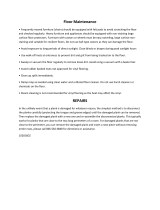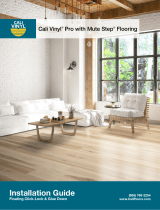Page is loading ...

Read entire installation instructions prior to beginning installation.
Improper installation of the ooring or deciencies related to site
conditions may result in failure of the I4F Locking System and will
void your warranty. Owner/installer assumes all responsibility for
nal inspection and acceptance of product prior to installation.
Job-site Evaluation:
Calculate the room size prior to installation. Add 10% to total ooring
quantity needed to cover oor surface for cutting waste.
Determine the direction the oor will be installed. It is recommended
that the ooring be installed parallel to the longest outside wall or
parallel to the main light source for optimal appearance.
Installations greater than 75 lineal feet in any direction will require the
use of transition moldings.
¼” expansion space is required at all walls and vertical obstructions
(cabinets, doors, replaces, etc.). Door jambs or casings should be
undercut to to allow for required expansion space.
Expansion space will be covered with base or quarter round/shoe
moldings that are afxed to the wall. Never afx moldings to the oor.
While the ooring is resistant to water, it is not a moisture barrier.
Moisture does not affect the integrity of the oor, however mold/
mildew growth can occur from prolonged exposure to moisture. Ensure
that suboors are dry prior to onset of installation and that a moisture
barrier is installed between the ground and suboor. Concrete should
be cured and tested for moisture.
Acclimate ooring for a minimum of 12 hours prior to installation in
the area where it is to be installed. Room temperature and relative
humidity must be consistent with normal, year round living conditions
for at least one week prior to installation. Temperature must be
maintained between 60-80 degrees F with relative humidity range
between 30-50%, before and during installation.
Substrate must be clean and free of dirt, debris, or any contaminates;
structurally sound; and level to within 3/16” over a 10 foot radius.
Carefully examine each piece of ooring for visible defects prior
to installation. Ensure there is sufcient natural or articial lighting
for thorough inspection of the ooring with regard to nish, color,
texture and sheen. Do not install any piece of ooring that may be
considered questionable in appearance or quality. Installer assumes
all responsibility for acceptance of ooring installed with visible or
manufacturing defects.
Check cartons to insure that the item number and lot number are the
same for all material to be installed. Work from 2-3 cartons at a time to
insure the best representation of pattern, color and design.
Tools needed:
Tape measure, pencil, chalk line, circular or hand saw, miter saw, utility
knife, rubber mallet, ¼” expansion spacers
Acceptable Suboors:
Interior grade ½” plywood or particleboard; ¾” OSB; existing
hardwood oor (sound and well bonded); concrete; existing ceramic
tile (well bonded); existing resilient/vinyl ooring (well bonded).
Suboor Preparation:
Wood suboors (plywood, particleboard, OSB) must be dry and
structurally sound. Nail or screw loose subooring every 6” along joists
to secure. Level low spots with a Portland based leveling compound,
and sand down any high areas to insure levelness of the substrate.
Concrete suboors must be at least 60 days old and fully cured, with
a minimum of 6-mil poly lm between the ground and the concrete.
Concrete should be dry, clean, and level to within 3/16” in a 10 foot
radius. Level low spots with a Portland based leveling compound, and
grind high spots to insure oor is level.
Existing hardwood oors must be secure and well bonded to the
suboor. Repair any loose boards or squeaks prior to installation.
Ceramic tile and resilient ooring must be secure and well bonded
to the suboor. Grout lines should be lled with Portland based
leveling compound. Do not install over perimeter glued resilient
oor covering.
Sweep or vacuum suboor to remove any loose dust or dirt particles.
Starting the Installation:
Before starting, rst measure the width of the room, and divide the
room’s width by the width of the plank. If the last row of planks
will be less than 2” wide, you will need to cut the rst row of
planks in such a way that the rst and last rows will have the same
approximate width.
You should begin your installation starting in the left hand corner
of the room. Measure the same distance from the wall at several
points and snap a chalk line. The distance you measure from the
wall should be the width of the 2 planks (or the standard width of
the plank and the cut plank), plus ¼” for required expansion space.
Expansion spacers should be placed along all walls, and at all
vertical obstructions (walls, cabinets, replaces, etc.), and remain in
place until installation is completed.
Figure 1: Planks should be staggered in a brick like pattern, with
at least 8” (or 25% of the length of the plank) between end joint of
adjacent planks. No plank less than 6” should be installed.
It is very important that the rst two rows are installed properly.
Installation will alternate back and forth between rows one and two,
for the rst two rows only. The rst row of planks will be placed with
the grooved edge facing outward into the room.
Figure 2: Begin by cutting plank 1 in half. Position the cut end of
plank 1 against the wall in the left corner of the room.
Figure 3: Use a full length for Plank 2 which will be installed in the
second row. Align plank 2 at an angle, onto the long side of plank 1
making sure there are no gaps. Drop plank 2 to lock in place.
Installation Instructions for Flooring
Products with I4F Licensed Locking System
www.innova�ons4flooring.com
PREPARE FLOOR
In case of an uneven floor, place underlayment. Set spacers of equal
thickness, appropriately distanced, for the required expansion gap.
INSTALL 1 PLANK
It is very important that the first row is installed straightly. To realize this,
installation alternates back and forth between rows one and two, for the
first two rows only. Start with a small plank (1) and position this plank
close to the wall.
INSTALL 2 PLANK
Now select a long plank (2). Using the Click4U angle system, angle the
long side of plank 2 on to the long side of plank 1. Drop plank 2 to lock.
Make sure there are no gaps.
ENGAGE 3 PLANK ON LONG SIDE
Take another long plank (3). Repeating the previous step, insert the long
side of plank 3 into the long side of plank 2. Then slide plank 3 to your
left until the short side is in contact with the short side of plank 1.
ESTABLISH STAGGER AND ALIGN TOOLS
Products should be staggered in bricklaid pattern, stagger equal to half
of a plank. Tools needed: planks, underlayment, spacers, rubber mallet.
1
2
3
4
11 12 13
21 22
Page 1/2
ENGAGE 3 PLANK ON SHORT SIDE (Part I)
Using the 3L TripleLock one piece drop-lock system, drop the short side
of plank 3 onto the short side of plank 1.
ST ND
RD RD
© 2018
2
1
3
4
5
6
Installa�on Instruc�ons
Engaging 3L TripleLock and Click4U using a rubber mallet
2
www.innova�ons4flooring.com
PREPARE FLOOR
In case of an uneven floor, place underlayment. Set spacers of equal
thickness, appropriately distanced, for the required expansion gap.
INSTALL 1 PLANK
It is very important that the first row is installed straightly. To realize this,
installation alternates back and forth between rows one and two, for the
first two rows only. Start with a small plank (1) and position this plank
close to the wall.
INSTALL 2 PLANK
Now select a long plank (2). Using the Click4U angle system, angle the
long side of plank 2 on to the long side of plank 1. Drop plank 2 to lock.
Make sure there are no gaps.
ENGAGE 3 PLANK ON LONG SIDE
Take another long plank (3). Repeating the previous step, insert the long
side of plank 3 into the long side of plank 2. Then slide plank 3 to your
left until the short side is in contact with the short side of plank 1.
ESTABLISH STAGGER AND ALIGN TOOLS
Products should be staggered in bricklaid pattern, stagger equal to half
of a plank. Tools needed: planks, underlayment, spacers, rubber mallet.
1
2
3
4
11 12 13
21 22
Page 1/2
ENGAGE 3 PLANK ON SHORT SIDE (Part I)
Using the 3L TripleLock one piece drop-lock system, drop the short side
of plank 3 onto the short side of plank 1.
ST ND
RD RD
© 2018
2
1
3
4
5
6
Installa�on Instruc�ons
Engaging 3L TripleLock and Click4U using a rubber mallet
3
1
2
3
4
11 12 13
21 22
1
31 32
41 42 43
33
1

Figure 4: Working from the wall, insert plank 3 into the long side
of plank 2.
Figure 5: Slide plank 3 to your left until the short side is in contact
with the short side of plank 1. Drop the short side of plank 3
onto the short side of plank 1 making sure that there is no gap
between the short side of plank 1 and plank 3.
Figure 6: Using a rubber mallet, lightly tap the joint on the short
side to engage the locking system.
Figure 7: Continue alternating planks on rows 1 and 2. Insure
planks are properly aligned along the chalk line and against the
spacers. Finish rows 1 and 2 in this manner, cutting planks at the
end of the row as necessary. Insure that the end planks are a
minimum of 6” in length. If necessary, adjust the length of starter
pieces to insure minimum plank lengths for each row, with proper
end joint stagger row to row.
Installation of all additional rows will start by angling a plank on
the long side, and sliding plank to the left until the short sides are
in contact. Lock the short side as instructed for rows 1 and 2 using
a rubber mallet to engage locking system as shown in Figure 5.
When installing the last row, you may need to use a pull bar to
lock the long side of the planks together.
Once installation is completed, remove spacers and cover
expansion space with trim. Do not afx trim to the oor as this
will prevent free movement of the oor.
Preventive Care:
The easiest way to maintain the optimal look and performance of
your oor is to reduce the amount of dirt, grit and moisture with
an effective barrier mat. This should be cleaned regularly. The use
of rubber-backed or coco-ber mats is NOT acceptable, as they
are known to stain resilient oors.
Never slide heavy furniture or ttings over an unprotected oor.
Severe scratching or damage may occur as a result. The oor
should be protected from wheels, casters or feet of ttings and
furniture, avoiding rubber products, which may stain the oor.
Use hard plastic or felt pads under heavy furniture to prevent
point loads. Use at, polished metal glides with a minimum
diameter of 1” (25 mm) under chairs and stools. These should
have a rounded edge and pivot to remain in at contact with the
oor. Non-staining felt pads can also be used, provided they are
changed on a regular basis to prevent dirt, debris and grit build-
up. Wide, non-staining casters at least 2” (50 mm) in diameter,
or oor protectors should be used on rolling furniture, such as
ofce chairs.
Furniture polish and window cleaning agents should be applied
directly to a cloth to avoid overspray or spillage onto the oor.
Contact with some agents, such as silicone, will make the oor
surface extremely slippery, which may result in accidents.
Regular Maintenance:
Sweep or vacuum regularly to remove dust and loose debris,
then clean with an approved oor cleaner (or cleaner specically
formulated for use on resilient oor covering) in accordance with
the manufacturer’s instructions, and allow to dry. Always remove
excess water to prevent slip and fall hazards. Do not use soap-
based detergents, caustic or abrasive cleaners.
Most cleaning agents will not harm the oor, however all residue
of cleaning agents should be removed immediately to avoid
discoloration. The following substances may stain or discolor
resilient ooring: tar, nail-polish, varnish, some spices, shoe
polish, lipstick, solvent-based paints, rubber mats, coco-ber
mats, asphalt, permanent markers, crayons, hair dye.
Additional considerations for oor care:
• Never use a steam mop on the ooring. Use of steam mops
may cause damage to your oor.
• Always use clean oor care applicators. Use of dirty applicators
redistributes the dirt throughout the oor surface.
• Do not mix cleaning products from different manufacturers –
they may not be compatible.
• Wipe up spills immediately.
• Remove excess water from oor.
• Take precautions to prevent dark rubber from coming into
contact with the oor.
• Never deviate from the manufacturer’s recommended
instructions for use of maintenance products.
• Use warning signs to advise that cleaning is in progress – wet
oors are slippery and may present a slip/fall hazard
• Protect against exposure to direct sunlight through the use
of curtains, blinds or solar lm to protect against thermal
dimensional changes.
www.innova�ons4flooring.com
PREPARE FLOOR
In case of an uneven floor, place underlayment. Set spacers of equal
thickness, appropriately distanced, for the required expansion gap.
INSTALL 1 PLANK
It is very important that the first row is installed straightly. To realize this,
installation alternates back and forth between rows one and two, for the
first two rows only. Start with a small plank (1) and position this plank
close to the wall.
INSTALL 2 PLANK
Now select a long plank (2). Using the Click4U angle system, angle the
long side of plank 2 on to the long side of plank 1. Drop plank 2 to lock.
Make sure there are no gaps.
ENGAGE 3 PLANK ON LONG SIDE
Take another long plank (3). Repeating the previous step, insert the long
side of plank 3 into the long side of plank 2. Then slide plank 3 to your
left until the short side is in contact with the short side of plank 1.
ESTABLISH STAGGER AND ALIGN TOOLS
Products should be staggered in bricklaid pattern, stagger equal to half
of a plank. Tools needed: planks, underlayment, spacers, rubber mallet.
1
2
3
4
11 12 13
21 22
Page 1/2
ENGAGE 3 PLANK ON SHORT SIDE (Part I)
Using the 3L TripleLock one piece drop-lock system, drop the short side
of plank 3 onto the short side of plank 1.
ST ND
RD RD
© 2018
2
1
3
4
5
6
Installa�on Instruc�ons
Engaging 3L TripleLock and Click4U using a rubber mallet
4
www.innova�ons4flooring.com
PREPARE FLOOR
In case of an uneven floor, place underlayment. Set spacers of equal
thickness, appropriately distanced, for the required expansion gap.
INSTALL 1 PLANK
It is very important that the first row is installed straightly. To realize this,
installation alternates back and forth between rows one and two, for the
first two rows only. Start with a small plank (1) and position this plank
close to the wall.
INSTALL 2 PLANK
Now select a long plank (2). Using the Click4U angle system, angle the
long side of plank 2 on to the long side of plank 1. Drop plank 2 to lock.
Make sure there are no gaps.
ENGAGE 3 PLANK ON LONG SIDE
Take another long plank (3). Repeating the previous step, insert the long
side of plank 3 into the long side of plank 2. Then slide plank 3 to your
left until the short side is in contact with the short side of plank 1.
ESTABLISH STAGGER AND ALIGN TOOLS
Products should be staggered in bricklaid pattern, stagger equal to half
of a plank. Tools needed: planks, underlayment, spacers, rubber mallet.
1
2
3
4
11 12 13
21 22
Page 1/2
ENGAGE 3 PLANK ON SHORT SIDE (Part I)
Using the 3L TripleLock one piece drop-lock system, drop the short side
of plank 3 onto the short side of plank 1.
ST ND
RD RD
© 2018
2
1
3
4
5
6
Installa�on Instruc�ons
Engaging 3L TripleLock and Click4U using a rubber mallet
5
7
Page 1/2
ENGAGE 3 PLANK ON SHORT SIDE (Part II)
Using a rubber mallet slightly tap the joints on the short side to secure.
This ensures 3x locking.
FINISH ROWS 1 AND 2
Continue alternating planks on rows 1 and 2 to avoid misalignment. From
row 3 onwards, installation does not require alternating rows. Install one
row after the other by starting with angling on the long side, sliding until
the short sides are in contact and then locking the short side.
SECURING PLANKS
As you go, don’t forget to use a rubber mallet on the short sides to secure
the locking.
FINALIZE FLOOR
Finished? Remove spacers and cover gaps with a trim.
10
DISASSEMBLING THE SHORT SIDE
Disassemble the row by sliding apart the planks on the short side.
DISASSEMBLING THE LONG SIDE
Lift up the entire row in the same angle as you did during installation,
then slide the rows apart.
RD
www.innova�ons4flooring.com
Page 2/2
© 2018
9
12
8
11
Installa�on Instruc�ons
Engaging 3L TripleLock and Click4U using a rubber mallet
6
7
Page 1/2
ENGAGE 3 PLANK ON SHORT SIDE (Part II)
Using a rubber mallet slightly tap the joints on the short side to secure.
This ensures 3x locking.
FINISH ROWS 1 AND 2
Continue alternating planks on rows 1 and 2 to avoid misalignment. From
row 3 onwards, installation does not require alternating rows. Install one
row after the other by starting with angling on the long side, sliding until
the short sides are in contact and then locking the short side.
SECURING PLANKS
As you go, don’t forget to use a rubber mallet on the short sides to secure
the locking.
FINALIZE FLOOR
Finished? Remove spacers and cover gaps with a trim.
10
DISASSEMBLING THE SHORT SIDE
Disassemble the row by sliding apart the planks on the short side.
DISASSEMBLING THE LONG SIDE
Lift up the entire row in the same angle as you did during installation,
then slide the rows apart.
RD
www.innova�ons4flooring.com
Page 2/2
© 2018
9
12
8
11
Installa�on Instruc�ons
Engaging 3L TripleLock and Click4U using a rubber mallet
7
10850 Train Ct, Houston, TX 77041 | [email protected]
/







